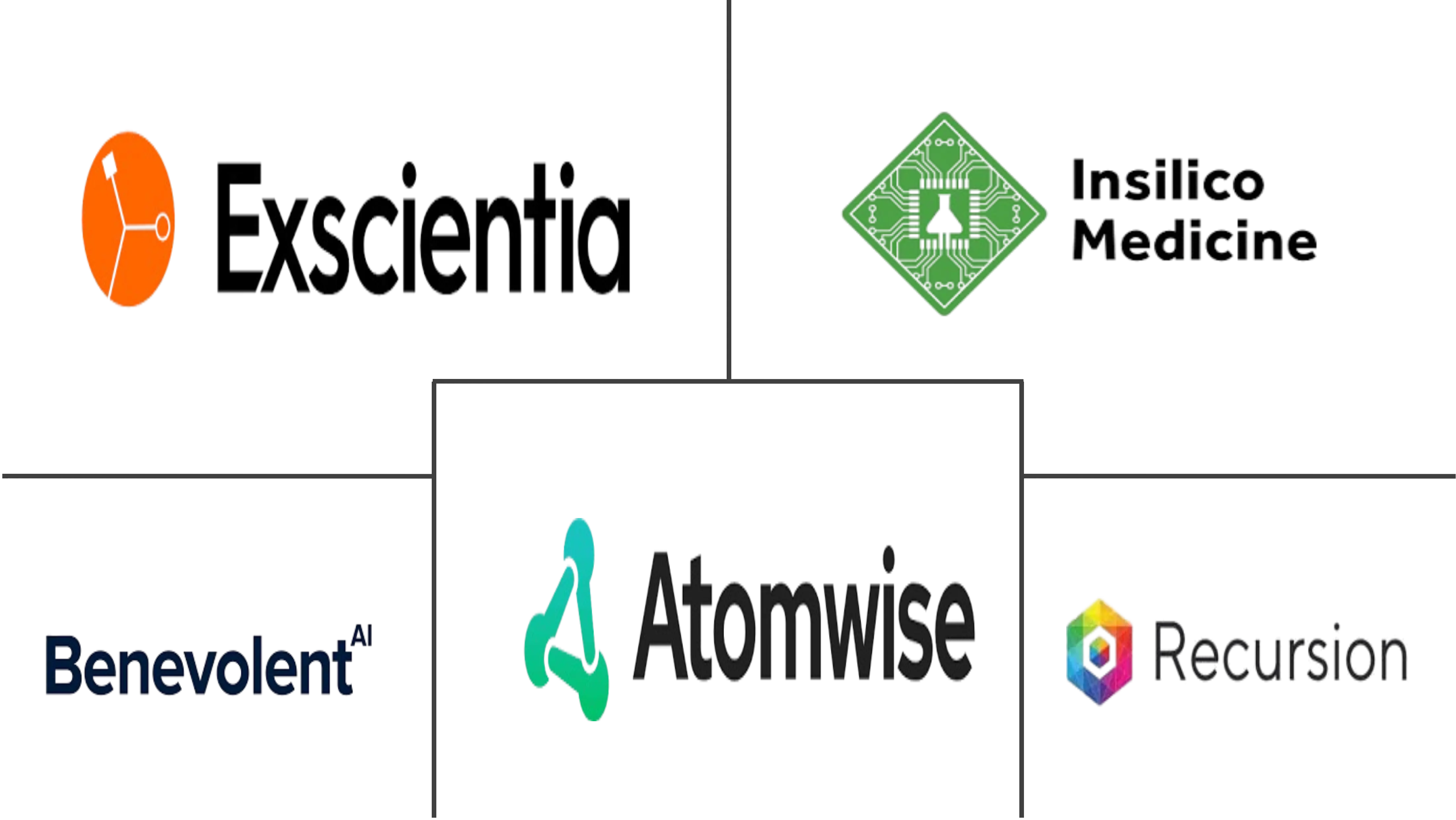Artificial Intelligence In Drug Discovery Market Size and Share
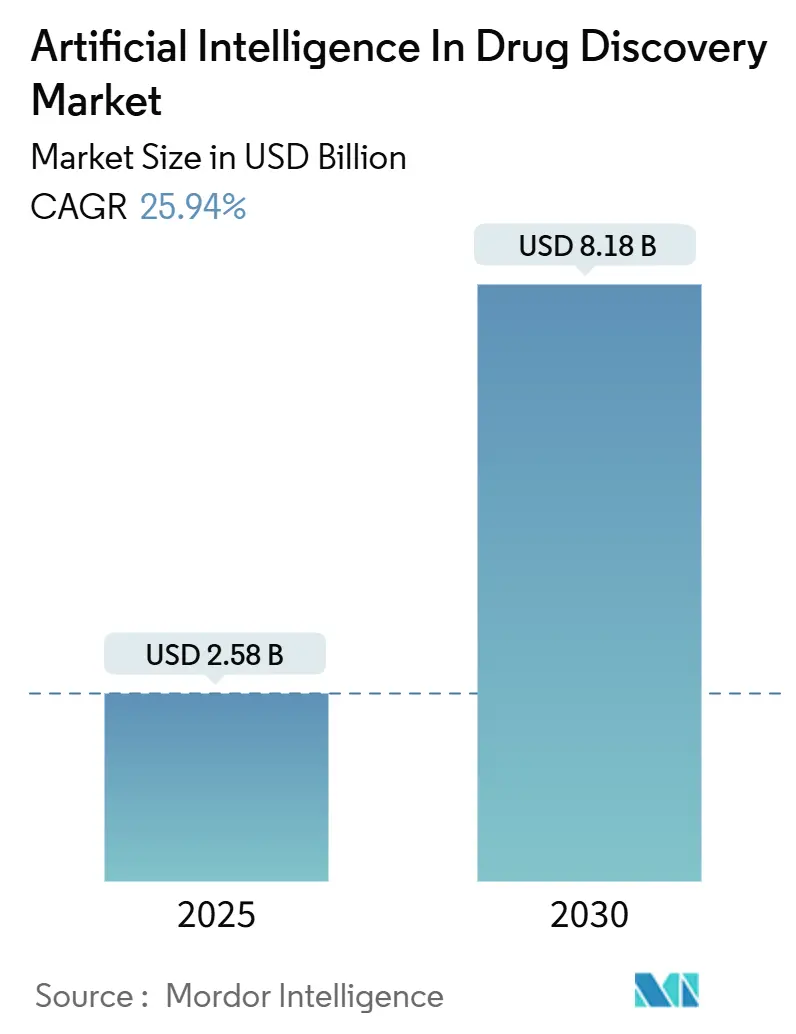
Artificial Intelligence In Drug Discovery Market Analysis by Mordor Intelligence
The current AI in Drug Discovery market size is valued at USD 2.58 billion in 2025 and is forecast to expand to USD 8.18 billion by 2030, registering a healthy 25.94 % CAGR over the period. This growth outlook reflects a structural shift inside pharmaceutical research, where artificial intelligence already reduces average discovery timelines from several years to well under twenty-four months. A further boost comes from the industry’s pursuit of cost savings, since the average spend to bring a new drug to market comfortably exceeds USD 2 billion. Investors are increasingly willing to fund AI-focused platforms because compressed timelines improve capital efficiency and tilt risk-reward profiles in favor of earlier returns. A visible pipeline of AI-generated molecules now moving into clinical studies reinforces commercial confidence, and continuous algorithm improvements create network effects that keep the technology’s adoption curve steep.
A second influence shaping the AI in Drug Discovery industry is the widening availability of high-quality biological data. Multi-omics datasets, large language repositories of biomedical literature, and image-based phenotypic screens collectively feed advanced models with the depth required to recognize nuanced patterns in disease biology. The commercial value of these data assets is rising, and companies that own proprietary repositories gather durable competitive advantages. Sovereign data regulations and audit requirements are also maturing, prompting firms to invest in secure cloud infrastructure that supports compliant, scalable AI development. As a result, growth momentum now reflects both technological progress and ecosystem preparedness, with participants ranging from specialist start-ups to top-tier pharmaceutical companies competing on differentiated data ownership rather than algorithmic novelty alone.
Key Report Takeaways
- The AI in Drug Discovery market size is forecast to add USD 5.6 billion of new value between 2025 and 2030, equal to an extra USD 1.12 billion in annual incremental revenue on average.
- Software retains the largest component share, yet professional services post the quickest expansion because pharmaceutical firms lack in-house AI skills.
- Machine learning remains the technology foundation, but quantum-assisted methods post the strongest relative gains as hardware becomes accessible on public clouds.
- Target identification leads present-day use cases, yet de novo molecular design records the fastest growth thanks to generative techniques.
- Small molecules still dominate, although gene and cell therapy pipelines show the steepest CAGR as algorithms adapt to complex biological payloads.
- North America keeps top regional market share, while Asia-Pacific records the fastest regional growth on heavy public investment and abundant AI talent.
- Consolidation accelerates; access to unique, well-labeled datasets now represents the strongest barrier to entry.
Global Artificial Intelligence In Drug Discovery Market Trends and Insights
Driver Impact Analysis
| Market Driver | (~) % Impact on CAGR | Forecast Geographic Relevance | Impact Timeline |
|---|---|---|---|
| Escalating global biopharma R&D-cost pressures | +2.1 % | Global | Short term (≤ 2 years) |
| Escalating prevalence of chronic and infectious diseases | +1.8 % | Asia-Pacific, North America | Medium term (2-4 years) |
| Rising collaboration between pharma and AI companies | +2.3 % | Europe, North America | Medium term (2-4 years) |
| Rapid growth of high-quality multi-omics, imaging and real-world clinical datasets | +2.0 % | Global | Long term (≥ 4 years) |
| Rapid cloud GPU/TPU cost declines and bio-specific AI services | +1.5 % | Global | Short term (≤ 2 years) |
| Robust venture-capital inflows and strategic Big-Pharma investments | +1.7 % | North America, Europe | Medium term (2-4 years) |
| Source: Mordor Intelligence | |||
Escalating Global Biopharma R&D-Cost Pressures
The AI in Drug Discovery market is benefiting from relentless pressure on pharmaceutical R&D budgets, which continue to escalate even as late-stage attrition rates remain high. AI tools address this dilemma by filtering out low-probability candidates early, thereby lowering the number of costly laboratory and animal experiments. Investors observe that successful early identification translates directly into portfolio de-risking, motivating continued capital inflows. A knock-on effect is that smaller biotechnology firms can now compete with larger peers by outsourcing access to powerful cloud-based AI platforms instead of building expensive in-house wet-lab infrastructures.
Escalating Prevalence of Chronic and Infectious Diseases
Rising global incidence of cancer, cardiovascular ailments, and periodic outbreaks of infectious diseases enlarges the addressable opportunity for novel therapeutics. AI accelerates hypothesis generation across these indications by stitching together genomics, proteomics, and clinical records into coherent disease signatures. Real-world evidence collected during the COVID-19 pandemic created a blueprint for rapid therapeutic iteration that now informs oncology and immunology programs. This transfer of learning drives cross-fertilization among therapeutic areas, and firms that mastered pandemic-era workflows are extending their reach into chronic diseases with complex molecular etiologies.
Rising Collaboration Between Pharma and AI Companies
Strategic partnerships have moved from exploratory pilots to multi-year cornerstone agreements, and upfront payments exceeding USD 30 million have become customary. Pharmaceutical companies favor selective alliances targeting defined disease classes rather than blanket platform access, indicating higher confidence in AI’s ability to produce tangible assets [1]Bristol Myers Squibb Staff, “Bristol Myers Squibb and VantAI Announce AI-Driven Drug Discovery Collaboration,” Bristol Myers Squibb Newsroom, news.bms.com. Collaboration structures now include equity components that align incentives and signal mutual commitment. These arrangements also create knowledge spill-overs, as internal teams upskill while working alongside AI specialists.
Rapid Growth of High-Quality Multi-Omics and Clinical Datasets
The volume of proprietary biological data held by leading AI drug discovery companies already exceeds tens of petabytes, and the rate is accelerating. Combining image-based cellular phenotypes with transcriptomics and metabolomics delivers a multidimensional view of disease pathways, enabling models to infer cause-and-effect relationships that conventional analytics miss. Firms that curate, label, and continuously expand such datasets gather compounding advantages because model performance improves with scale. This dynamic nudges the competitive battlefield from algorithmic innovation toward data acquisition and stewardship.
Rapid Cloud GPU/TPU Cost Declines and Bio-Specific AI Services
Major cloud vendors have cut pricing for high-performance chips while introducing compliance modules tailored to Good Laboratory Practice. The lower entry cost lets mid-cap biotechs run compute-heavy tasks like molecular-dynamics simulations that once needed on-premise clusters. The resulting democratisation of power computing is broadening the AI in Drug Discovery industry user base beyond large pharmaceutical enterprises [2]Mike Stefaniak, Cas Starsiak and Rama Ponnuswami, “High-Performance Generative AI on Amazon EKS,” AWS Blog, aws.amazon.com
Restraint Impact Analysis
| Market Restraint | (~) % Impact on CAGR | Forecast Geographic Relevance | Impact Timeline |
|---|---|---|---|
| Persistent “black-box” explainability concerns among regulators, payers and clinicians | −1.9 % | North America, Europe | Short term (≤ 2 years) |
| Acute shortage of cross-disciplinary talent | −1.6 % | Global | Medium term (2-4 years) |
| Fragmented, non-standardised assay and clinical data silos limiting model generalisability | −1.3 % | Asia-Pacific, Europe | Long term (≥ 4 years) |
| Budget constraints and errors associated with data management and standardisation | −1.1 % | Emerging markets | Short term (≤ 2 years) |
| Source: Mordor Intelligence | |||
Persistent “Black-Box” Explainability Concerns
Regulators now scrutinize the transparency of AI predictions, and draft guidance from the United States Food and Drug Administration highlights a preference for interpretable models. Development teams therefore pursue architectures that maintain predictive power while revealing underlying biological rationales. Projects that incorporate feature attribution maps or mechanistic pathway visualizations more easily secure internal stakeholder buy-in and regulatory dialogue. In effect, explainability is transitioning from a compliance hurdle to a source of competitive differentiation.
Acute Shortage of Cross-Disciplinary Talent
Demand for professionals who understand both medicinal chemistry and advanced machine learning continues to outstrip supply. Leading organizations respond by launching in-house academies and postgraduate partnerships that cultivate domain fluency across disciplines. Firms capable of blending drug discovery veterans with data scientists consistently translate computational predictions into viable laboratory experiments faster than rivals. Talent scarcity therefore reinforces the commercial logic behind outsourcing AI services to specialized vendors.
Segment Analysis
Component: Software Dominates While Services Accelerate
Software accounts for 72 % of AI in Drug Discovery market share in 2024, serving as the backbone for molecule generation, docking, and scoring. Continuous algorithm patches arrive via automatic updates, allowing users to benefit from collective learning across installations. Professional services log a forecast 28.6 % CAGR because companies without specialist teams outsource model configuration and compliance documentation. One observation is that subscription pricing now aligns with milestone readouts, tying cost to clear scientific outputs [3]NVIDIA Staff, “High Throughput AI-Driven Drug Discovery Pipeline,” NVIDIA Technical Blog, nvidia.com.
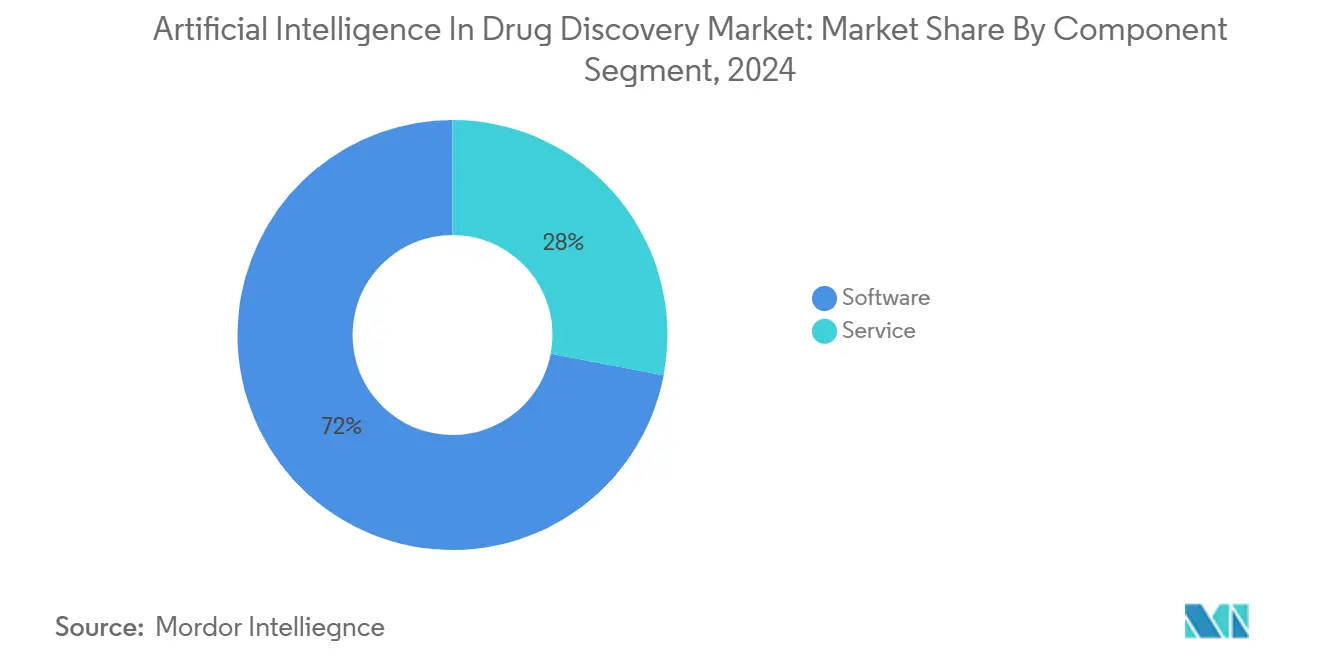
Note: Segment shares of all individual segments available upon report purchase
Technology: Machine Learning Foundations Support Quantum Leap
Machine learning accounts for 66% of AI in Drug Discovery market share in 2024, reflecting its proven capacity to analyze structured and unstructured biomedical data. Classical methods such as gradient-boosted trees remain valuable for well-defined tasks, while convolutional and graph neural networks unlock non-linear relationships in protein-ligand interactions. Quantum machine learning, though nascent, is projected to expand at a 29.1 % CAGR from 2025-2030, potentially redefining search space boundaries by evaluating complex molecular conformations in parallel [4]Jerry Chow, “Advancing the IBM Quantum Roadmap,” IBM Research Blog, research.ibm.com.
Integration of quantum computing into standard workflows already yields hybrid approaches that offload the most computationally intensive steps onto quantum hardware. These early successes encourage renewed venture funding into quantum algorithms tailored for medicinal chemistry. Meanwhile, natural language processing and large language models accelerate literature mining, enabling rapid hypothesis testing based on decades of scientific publications.
Application: Target Identification Leads While De Novo Design Accelerates
Target identification holds 28% AI in Drug Discovery market share in 2024 and remains the gateway to downstream success because incorrect targets cascade into costly late-stage failures. AI approaches screen multi-omics data for druggable nodes within disease networks, concentrating bench resources on the most promising mechanisms. De novo drug design shows the strongest growth at a 27.9 % CAGR through 2030 as generative models assemble novel chemical structures that satisfy multiple property constraints simultaneously.
Hit-to-lead workflows profit from deep learning that forecasts structure-activity relationships with rising precision, trimming redundant synthesis cycles. Candidate screening increasingly incorporates early predictions of safety and pharmacokinetic characteristics, raising the probability that molecules advance smoothly into pre-clinical studies. Drug repurposing, supported by AI matching of existing compounds to new indications, shortens timelines when speed to clinic is paramount.
Drug Type: Small Molecules Maintain Dominance While Cell Therapies Surge
Small molecules represent 58 % of AI in Drug Discovery market size in 2024, supported by decades of accumulated chemical knowledge and standardized development pathways. Mature datasets allow algorithms to draw on extensive precedent when evaluating drug-likeness and synthesizability. Gene and cell therapies, though currently smaller in absolute revenue, are forecast to post a 30% CAGR between 2025-2030 as models adapt to complex biological vectors and editing tools.
Biologics reside in the middle ground, benefitting from AI-enabled antibody design that refines binding affinities and reduces immunogenicity. The interplay between modality and algorithm type is becoming more explicit, with reinforcement learning driving fragment growth in small molecules, graph networks predicting epitope coverage in antibodies, and sequence-to-structure models guiding cell therapy vector optimization. Portfolio managers now weigh modality focus against organizational AI maturity when allocating capital.
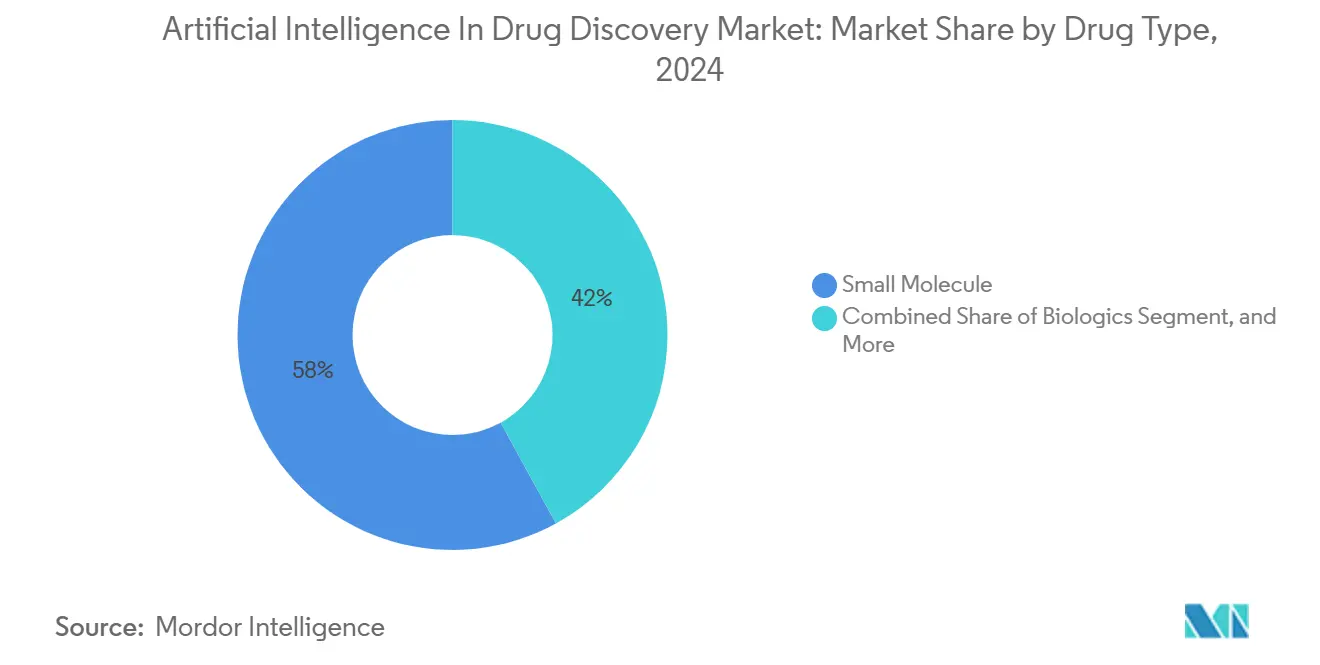
Note: Segment shares of all individual segments available upon report purchase
End User: Pharma Companies Lead While Academic Institutions Grow Faster
Pharmaceutical and biotechnology firms control 49% AI in Drug Discovery market share in 2024, leveraging scale and capital reserves to internalize sophisticated platforms. Their adoption rate is highest among global top-twenty companies that view AI as a strategic imperative for pipeline productivity. Academic and research institutes, while representing a smaller base, are expanding at a 28.4 % CAGR through 2030 as grant funding earmarks AI initiatives and universities spin out focused start-ups.
Contract research organizations and government laboratories populate an “other” category that increasingly influences industry trajectories. CROs incorporate AI to differentiate service offerings, positioning themselves as accelerators for sponsors looking to augment experimental capacity with computational insight. Government agencies in Asia are backing domestic AI platforms to cultivate self-reliance in medicine, introducing new competitive dynamics that emphasize national data sovereignty.
Geography Analysis
North America leads the AI in Drug Discovery market with 42% market share in 2024, anchored by a deep venture capital ecosystem, world-class academic centers, and a supportive regulatory climate. Dedicated initiatives such as an AI Small Molecule Drug Discovery Center at Mount Sinai demonstrate institutional commitment to digital approaches. The region’s leadership also reflects early-stage talent concentration, which feeds a virtuous cycle of company formation and downstream investment. Nevertheless, a maturing user base tempers growth rates relative to earlier years, suggesting that incremental innovation now hinges on continued regulatory clarity and cross-disciplinary training programs.
Asia-Pacific is the fastest growing territory, expected to advance at a 29.8% CAGR between 2025-2030. China’s strategic policy emphasis on pharmaceutical innovation spurs both public funding and private equity flows into domestic AI platforms. Japan leverages strength in robotics to complement AI-driven screening, South Korea deploys nationwide 5G infrastructure to increase data liquidity, and India contributes a large, cost-effective AI talent reservoir. Western companies increasingly partner with local entities to combine domain knowledge with regional data access, producing hybrid discovery pipelines that benefit all parties.
Europe occupies a pivotal position, distinguished by strong quantum computing research clusters and diverse public-private partnerships that emphasize responsible AI governance. The region’s strict data protection frameworks push companies to innovate privacy-preserving learning techniques while collaborating across borders. Smaller yet dynamic markets in the Middle East and South America are channeling sovereign wealth and development bank resources into AI infrastructure, betting that a first-mover stance in digital health can diversify their economies. Cross-regional specializations foster a networked innovation model in which discovery workflows span time zones, distributing risk and amplifying local strengths.
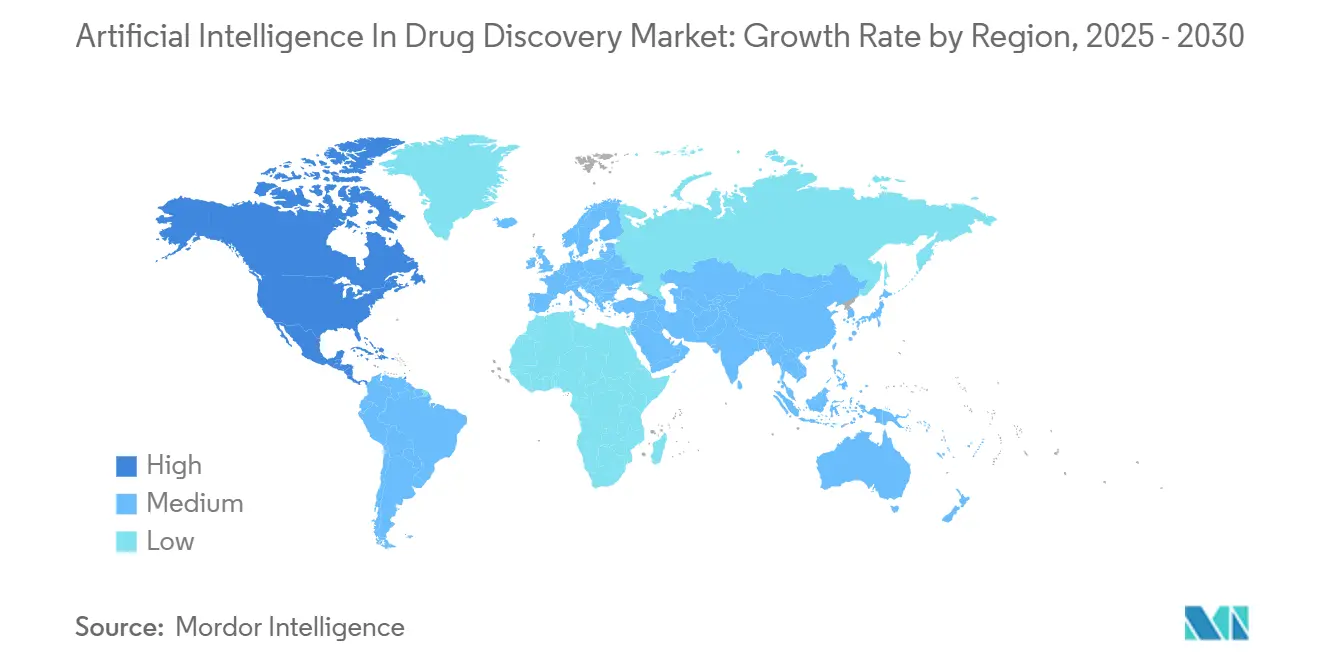
Competitive Landscape
Three converging player types define today’s AI in Drug Discovery industry. First, AI-native biotechs build discovery engines around proprietary algorithms and data, raising sizable venture rounds to prove platform scalability. Second, incumbent pharmaceutical companies incorporate AI through build-buy-partner strategies, often opting for multiple overlapping collaborations to hedge technical uncertainty. Third, technology giants with cloud and semiconductor expertise enter life sciences to monetize computing assets and machine learning libraries. No single cohort currently dominates, producing a moderately fragmented field where partnerships and data ownership, rather than code, determine influence.
Consolidation is gathering pace. The merger of two prominent AI biotechs valued at USD 688 million in 2024 illustrated that combining complementary data lakes and molecule-generation tools can accelerate clinical validation. As platforms mature, investors favor fewer, stronger contenders, expecting operational synergies and broader therapeutic coverage. Meanwhile, white-space analysis highlights unmet needs in infectious diseases and central nervous system disorders, therapeutic spaces traditionally considered high risk. AI’s capacity to unravel complex pathways ignites renewed optimism that these areas may host the next wave of breakthroughs.
Barriers to entry are rising along two axes. First, proprietary data holdings on cell images, omics profiles, and clinical outcomes compound in value as models learn from cumulative experiments. Second, regulatory expectations around traceable model provenance force newcomers to invest in documentation and quality systems from day one. Incumbents that mastered these processes now wield compelling differentiators when negotiating with prospective partners. Simultaneously, quantum computing specialists eager to apply novel hardware advances are forging joint ventures with discovery veterans to accelerate translation of early algorithms into pipeline milestones.
Artificial Intelligence In Drug Discovery Industry Leaders
-
Exscientia PLC
-
Insilico Medicine Inc.
-
BenevolentAI
-
Atomwise Inc.
-
Recursion Pharmaceuticals Inc.
- *Disclaimer: Major Players sorted in no particular order
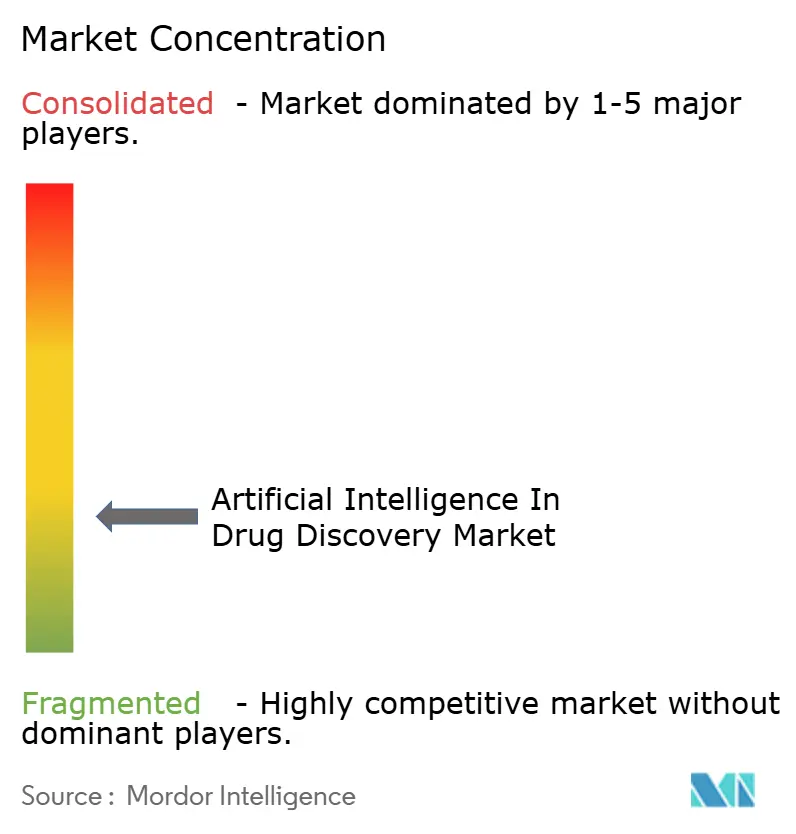
Recent Industry Developments
- February 2025: Incyte and Genesis Therapeutics formed a USD 30 million upfront alliance to apply the GEMS platform to small-molecule discovery.
- February 2025: Harbour BioMed and Insilico Medicine partnered to combine antibody generation technologies with generative AI for faster candidate selection.
- January 2025: Manas AI launched with USD 24.6 million seed funding to focus on aggressive cancers through human-AI collaborative design.
- January 2025: Mount Sinai unveiled an AI Small Molecule Drug Discovery Center to streamline academic–industry translation.
- January 2025: Absci partnered with Owkin to apply AI to immuno-oncology discovery programs, expanding Absci’s fourth collaboration inside twelve months.
- January 2025: Pfizer broadened its engagement with PostEra in a USD 610 million framework covering antibody-drug conjugates powered by the Proton platform.
- September 2024: Novartis signed a USD 1 billion deal with Generate: Biomedicines for generative AI-driven protein therapeutics development.
Research Methodology Framework and Report Scope
Market Definitions and Key Coverage
According to Mordor Intelligence, the artificial-intelligence-in-drug-discovery market covers all revenue generated when purpose-built AI software or cloud services (including machine-learning, deep-learning, and generative-AI tools) are licensed or contracted by pharmaceutical, biotechnology, or academic drug-research teams to accelerate target selection, hit generation, lead optimization, and pre-clinical assessment.
Scope exclusion: routine bio-informatics service fees and broad "AI in healthcare" platforms not marketed for drug-discovery workflows are left outside this study.
Segmentation Overview
- By Component
- Software
- Service
- By Technology
- Machine Learning
- Natural Language Processing
- Computer Vision
- Quantum Machine Learning
- By Application
- Target Identification & Validation
- Hit Generation & Prioritization
- Lead Optimization
- Candidate Screening
- Drug Repurposing
- De novo Drug Design
- Preclinical Safety & Toxicity Assessment
- By Drug Type
- Small Molecule
- Biologics
- Gene and Cell Therapy
- By Deployment
- Cloud-Based
- On-Premise
- By End User
- Pharmaceutical & Biotechnological Companies
- Academic & Research Institutes
- Others
- By Geography
- North America
- United States
- Canada
- Mexico
- Europe
- Germany
- United Kingdom
- France
- Italy
- Spain
- Rest of Europe
- Asia-Pacific
- China
- Japan
- India
- South Korea
- Australia
- Rest of Asia-Pacific
- Middle East
- GCC
- South Africa
- Rest of Middle East
- South America
- Brazil
- Argentina
- Rest of South America
- North America
Detailed Research Methodology and Data Validation
Primary Research
We held structured interviews with computational-chemistry directors, AI platform vendors, and CRO project leads across North America, Europe, and Asia-Pacific. The conversations clarified typical license pricing, adoption hurdles, and regional funding patterns, allowing us to stress-test desk assumptions and calibrate growth drivers.
Desk Research
Our analysts extracted baseline demand signals from public bodies such as the US FDA, EMA, NIH clinical-trial registry, USPTO patent filings, and OECD R&D expenditure dashboards, then paired them with shipment and contract values visible in customs databases like Volza and tender portals such as Tenders Info. Trade associations (BIO, EFPIA), peer-reviewed journals, and company 10-Ks supplied pipeline counts, average R&D cycle times, and disclosed AI-licensing deals. Paid datasets (D&B Hoovers for company financials and Questel for patent analytics) added granularity. The sources cited here are illustrative; many additional publications were reviewed to validate facts and fill gaps.
Market-Sizing & Forecasting
Top-down modeling starts with global drug-R&D spending and new molecular-entity (NME) filings; AI penetration rates by discovery stage are applied, with adjustments for average seat licenses and service bundles. Select bottom-up checks, such as revenue roll-ups from 30 sampled vendors and median annual contract value multiplied by active users, anchor the totals. Key variables include: (1) venture funding inflow to AI bio-techs, (2) oncology pre-clinical pipeline counts, (3) cloud-computing unit prices, (4) average cost-avoidance claimed per program, and (5) regional regulatory guidance releases. A multivariate-regression forecast links these drivers to AI spend, while scenario analysis tests upside from quantum-ML deployment.
Data Validation & Update Cycle
Outputs pass a three-layer review: automated anomaly flags, peer analyst audit, and sector-lead sign-off. Models refresh annually; interim updates trigger when funding spikes, landmark approvals, or landmark mergers alter the baseline.
Why Mordor's Artificial Intelligence In Drug Discovery Baseline Commands Reliability
Published estimates often diverge because firms pick differing inclusion criteria, currency years, and refresh cadences.
Key gap drivers here include whether computational chemistry tool revenue is blended with broader AI-healthcare sales, how aggressively future price deflation is assumed, and the cadence at which pipeline statistics are refreshed before model lock. Mordor reports isolate pure discovery-stage spending, use mixed ASP trajectories vetted with buyers, and update every twelve months; steps some publishers skip.
Benchmark comparison
| Market Size | Anonymized source | Primary gap driver |
|---|---|---|
| USD 2.58 B (2025) | Mordor Intelligence | - |
| USD 1.86 B (2024) | Global Consultancy A | Bundles early clinical AI tools; relies on five-year-old adoption rates |
| USD 1.90 B (2024) | Industry Journal B | Uses static licence prices and omits cloud-service revenue |
The comparison shows that once scope alignment and current pricing are applied, figures converge toward Mordor's balanced view, underscoring why decision-makers trust our consistently refreshed, variable-driven baseline.
Key Questions Answered in the Report
What is the expected AI in Drug Discovery market size by 2030?
The market is projected to reach USD 8.18 billion in 2030
Which component segment is growing fastest within the AI in Drug Discovery industry?
Professional services show the highest growth, forecast at a 28.6 % CAGR through 2030.
Why is Asia-Pacific the fastest growing region?
Large public funding programs, strong clinical trial infrastructure, and an expanding AI talent pool lift the region’s CAGR to 29.8 %.
How do AI tools cut discovery costs?
They prioritise high-probability targets and simulate molecule behaviour in silico, lowering laboratory experiments and reducing development cycles.
Page last updated on:
